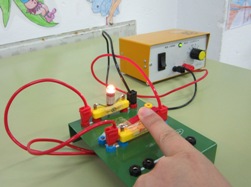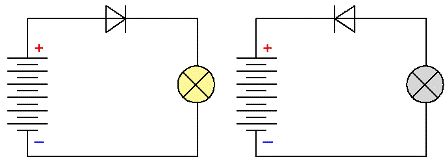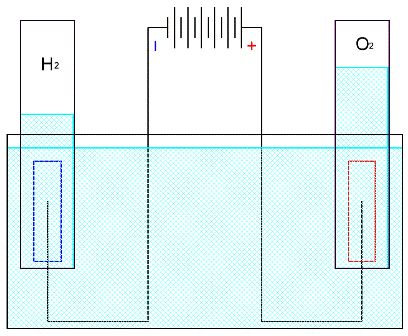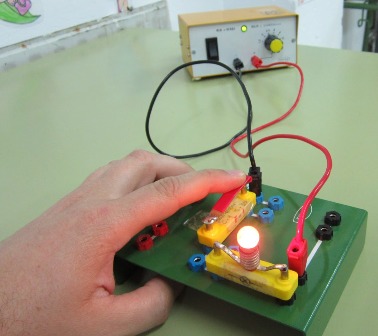Categories: Featured Articles » Interesting Facts
Number of views: 14370
Comments on the article: 1
Where does the electricity flow?
 An electric current arises in an electric circuit including a current source and a consumer of electricity. But in what direction does this current occur? It is traditionally believed that in the external circuit the current has a direction from the plus of the source to minus, while inside the power source it is from minus to plus.
An electric current arises in an electric circuit including a current source and a consumer of electricity. But in what direction does this current occur? It is traditionally believed that in the external circuit the current has a direction from the plus of the source to minus, while inside the power source it is from minus to plus.
Indeed, electric current is the ordered movement of electrically charged particles. If the conductor is made of metal, these particles are electrons - negatively charged particles. However, in the external circuit, the electrons move precisely from the minus (negative pole) to the plus (positive pole), and not from plus to minus.
If included in an external circuit semiconductor diode, it will become clear that current is possible only when the diode is connected by the cathode in the direction of the minus. From this it follows that the direction opposite to the actual motion of the electrons is taken as the direction of the electric current in the circuit.

If we trace the history of the formation of electrical engineering as an independent science, we can understand where such a paradoxical approach came from.
The American researcher Benjamin Franklin put forward in his time a unitary (unified) theory of electricity. According to this theory, electric matter is a weightless liquid that can flow out of some bodies, while accumulating in others.
According to Franklin, there is an electric fluid in all bodies, but bodies become electrified only when there is an excess or lack of electric fluid (electric fluid) in them. The lack of electric fluid (according to Franklin) meant negative electrification, and the excess - positive.
This was the beginning of the concepts of positive charge and negative charge. At the moment of connection of positively charged bodies with negatively charged bodies, electric fluid flows from a body with a large amount of electric fluid to bodies with a reduced amount of it. This is similar to a system of communicating vessels. A stable concept of electric current, the movement of electric charges, has entered into science.
This Franklin hypothesis preceded the electronic theory of conduction, but it turned out to be far from perfect. The French physicist Charles Dufe discovered that in reality there are two types of electricity, which individually obey the theory of Franklin, but are mutually neutralized upon contact. A new dualistic (dual) theory of electricity appeared, put forward by the natural scientist Robert Simmer on the basis of the experiments of Charles Dufe.
When rubbing, in order to electrify electrified bodies, not only the rubbed body, but also the rubbed one becomes charged. The dualistic theory claimed that in the ordinary state, the bodies contained two kinds of electric fluid and in different quantities that neutralize each other. Electrification was explained by a change in the ratio of negative and positive electricity in electrified bodies.

Both Franklin’s hypothesis and Simmer’s hypothesis successfully explained electrostatic phenomena and even competed with each other.
Invented in 1799 by a volt pole and discovery electrolysis phenomena led to the conclusion that during the electrolysis of solutions and liquids in them there are two opposite charges in the direction of movement of the charges - negative and positive. This was the triumph of the dualistic theory, because when water was decomposed, it was now possible to observe how oxygen bubbles were released on the positive electrode, while hydrogen was released on the negative electrode.
But not everything was smooth here. The amount of emitted gases turned out different. Hydrogen was released twice as much as oxygen.This baffled physicists. Then the chemists had no idea that in the water molecule there are two hydrogen atoms and only one oxygen atom.

These theories were not understood by everyone.
But in 1820, Andre-Marie Ampère, in a paper presented to members of the Paris Academy of Sciences, first decides to choose one of the directions of currents as the main one, but then gives a rule according to which it is possible to accurately determine the effect of magnets on electric currents.
In order not to talk all the time about two opposite currents of both electricity currents, in order to avoid unnecessary repetitions, Ampere decided to strictly take the direction of movement of positive electricity as the direction of electric current. So, for the first time by Ampere, the generally accepted rule of the direction of electric current was introduced so far.
Later, Maxwell himself adhered to this position, having invented the “gimlet” rule determining the direction of the magnetic field of the coil. But the question of the true direction of the electric current remained open. Faraday wrote that this state of affairs is only conditional, it is convenient for scientists, and helps them clearly determine the direction of currents. But this is only a convenient tool.
After Faraday discovered electromagnetic induction, it became necessary to determine the direction of the induced current. The Russian physicist Lenz gave a rule: if a metal conductor moves near a current or a magnet, then a galvanic current arises in it. And the direction of the emerging current is such that the fixed wire would come from its action into motion opposite to the initial displacement. Simple, easy to understand rule.
Even after the discovery of an electron, this convention has existed for more than a century and a half. With the invention of a device such as an electronic lamp, with the widespread introduction of semiconductors, difficulties began to arise. But electrical engineering, as before, operates on old definitions. Sometimes this causes real confusion. But making adjustments will cause more inconvenience.
See also at e.imadeself.com
:

